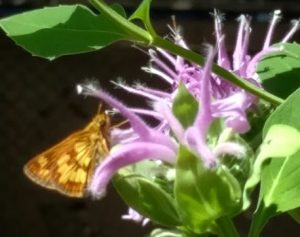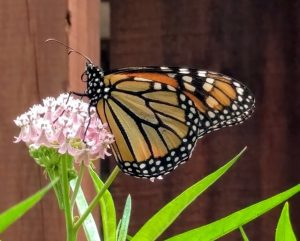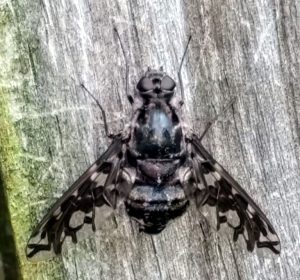By Edie Parnum
A 130-square foot cement-covered backyard —who would expect such a yard could be a haven for wildlife? The property is on a narrow street of rowhouses in Philadelphia. The nearest park is several miles away. Nonetheless, this garden is teeming with butterflies, bees, wasps, moths, and a host of other pollinating insects.
Navin, an avid amateur naturalist, moved to this property last fall. He saw the potential to attract pollinators with native plants in raised beds and containers. In early spring, he invited me for a Backyards for Nature consultation. Together we made a list of short and mid-sized perennials that bloom from early spring to late fall and are known to attract a variety of pollinators.
He purchased good quality plants from Good Host Plants, a native plant nursery in Philadelphia. He planted perennials in two raised beds that sit atop the cement. Others he planted in large, deep containers. He installed two trellises for growing vines.
It worked. In the spring bees and other insects found the Wild Columbine (Aquilegia canadense), Beardtongue (Penstemon digitalis). and Creeping Phlox (Phlox subulata). The summer blossoms of Swamp Milkweed (Asclepias incarnata), Butterfly Weed (A.tuberosa), Purple Coneflower (Echinacea purpurea), Joe-Pye Weed (Eutrochium purpureum), Dense Blazing Star (Liatris spicata), Cardinal Flower (Lobelia cardinalis), Wild Bergamot (Monarda fistulosa), Short-toothed Mountain Mint (Pycnanthemum muticum), and Orange Coneflower
(Rudbeckia fulgida) host many butterflies and other pollinators. The show continues this fall with Grey Goldenrod (Solidago nemoralis), New England Aster (Symphotrichum novae-angliae), and other asters. Trumpet Honeysuckle (Lonicera sempervirens) and Virginia Creeper (Parthenocissus quinquifolia) will bloom on the trellises.
On weekends Navin observes and photographs the wildlife in his
garden. He discovered Monarchs laying eggs on his Swamp Milkweed. An insatiable predator, a Carolina Mantis (our native mantid species) lurked nearby, so he decided to bring the Monarch eggs and caterpillars inside to raise them in safety. So far, he’s raised and released 34 adult Monarchs. An additional 47 are either chrysalises or caterpillars and will be released soon for their journey to Mexico. He’s also rearing BlackSwallowtail eggs and caterpillars that grow on parsley. According to Navin, nighttime is the best time for spotting the small eggs and caterpillars.
So far, he’s recognized ten additional butterfly species including Eastern Tiger Swallowtail, Red Admiral, and Eastern Tailed Blue. The biggest surprise was a Giant Swallowtail, a southern species rarely seen in
the Philadelphia area. Other insects are finding his garden, too. Navin observed a Snowberry Clearwing, a large day-flying moth, nectaring on blossoms like a hummingbird. A variety of bees, wasps, flies and moths feed on nectar and pollen. With so many insects, predators such as the Carolina mantis as well as spiders,lacewings, and parasitic wasps have located his yard, too. One day he spotted a lacewing eating aphids.
Navin offers advice to other wildlife gardeners with limited space. A great many plants can be crowded into small garden plots, raised beds, and large, deep containers. Prune the plants periodically to keep them short and use stakes before tall plants get floppy. Water frequently in hot weather.
Navin submits his wildlife sightings to iNaturalist, a nature record-keeping app. He photographs the butterflies and moths (both adults and caterpillars), bees, wasps, flies, beetles—in fact, any creature using his plants. He uploads these photos and the species names to iNaturalist. The dates and location are automatically included. When the species is unknown, iNaturalist experts can usually provide the identification. Scientists and other amateur naturalists can view and study Navin’s sightings and those of the other 137,000 iNaturalist users.
How do so many creatures find this yard? Certainly, adult butterflies and moths can fly. They’re wired to find nectar and pollen for their survival. With their chemical sensors, they can also locate the specific plants they require to lay their eggs. Other insects have powerful search mechanisms, too.
Navin will keep searching. He’ll find more creatures. After all, this garden is only 6 months old.







What an uplifting story! I have a suburban sized yard that I am slowly converting from grass and hosts to native plants …everywhere! The hum of life is now constant. I always think that if more people did what Navin did, it could truly transform our world. Revolution by gardening!
I meant hostas…not hosts. 🙂 I’m removing the last of them next spring.
Thanks, Laura. Yes, Navin’s experience is inspiring. We should all follow suit and encourage others to do so. “Revolution by gardening,” I like that.
Edie
Good luck, Laura! We need more suburban yards to be converted into native plant paradises too. I love your term, ‘Revolution by gardening’. I think we can make it happen. I’ve been trying to educate and convert my neighbors into planting more natives, we’ll see how that goes. 🙂